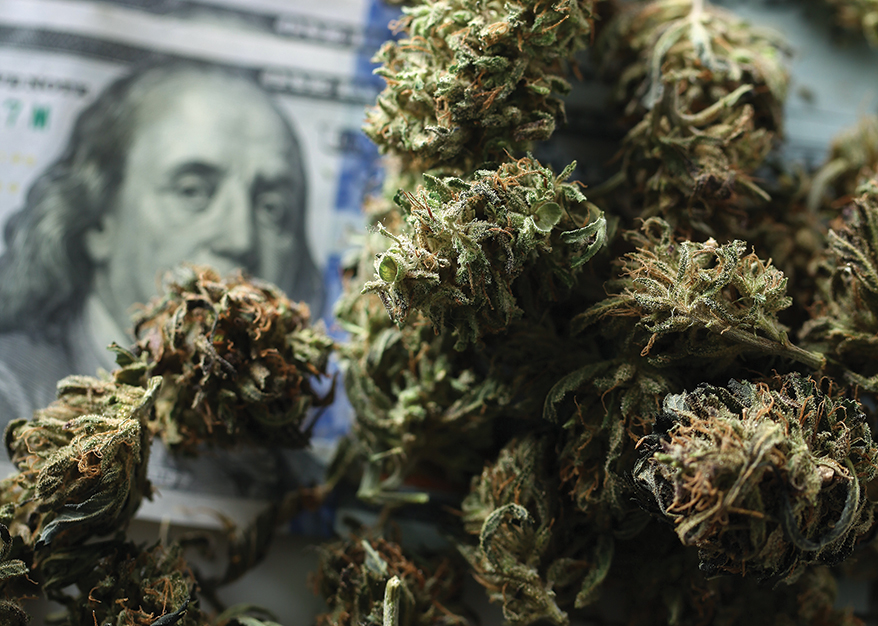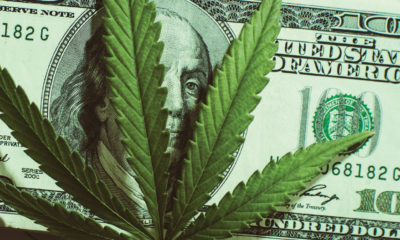THE GLOBAL CANNABIS 50 sports a combined market capitalization of roughly $25 billion. That’s about what Reynolds paid for Lorillard in 2014, AB InBev for Grupo Modelo in 2012, or Mars for Wrigley in 2008 (all adjusted for inflation).
In other words, there are any number of consumer packaged goods (CPG) companies that could swallow the Global Cannabis 50 whole if they wanted to do so. Some of those giants are likely to come looking for at least a snack when federal legalization finally arrives.
When those big CPG companies come shopping, they will face quite a challenge figuring out how this supply chain works. It’s vertically integrated in a way and at a level that hasn’t existed in the broader economy since before the Industrial Revolution.
Many state governments require legal operators to be vertically integrated via license. The biggest U.S. companies in cannabis, known as multi-state operators (MSOs), typically grow their own raw materials, manufacture their own products and sell them in their own stores. It’s as if General Mills grew the oats, made the Cheerios and sold boxes of product in owned-and-operated cereal stores.
That vertical integration has proven to be a key factor in the phenomenal growth of the companies at the top of the Global Cannabis 50. No doubt, capitalism will one day bring specialization to the cannabis supply chain, but for now the Global Cannabis 50 is dominated by U.S. companies that do it all. Because their topline revenue comes at the retail counter in a business that saw U.S. consumers spend $25.9 billion on cannabis in 2021 per Brightfield Group, a few MSOs have quickly acquired impressive scale.
Race to the Top
Take Curaleaf, the No. 1 company in the Global Cannabis 50. In October 2018, Curaleaf executed a reverse takeover (RTO) of a Canadian public shell and raised about $393 million (at today’s exchange rates) in a private placement at the equivalent of $8.50/share. It posted $57.5 million in revenue that year. Three years later in 2021, Curaleaf became the first cannabis company to break $1 billion in revenue, and it edged out Trulieve for the top spot in the Global Cannabis 50 by reporting $1.35 billion trailing 12-month (TTM) revenue through June 2022.
Trulieve has had a similar trajectory: Its RTO came in August 2018 as it posted $102.8 million in annual revenue, which exploded to $938.4 million in 2021 and $1.17 billion in its TTM ending June. The race for the top spot in the Global Cannabis 50 could have been even closer: if Trulieve had consolidated the revenue of the acquired Harvest Health and Wellness for the full third quarter of 2021, its TTM would have been $1.26 billion, just $28 million less than Curaleaf.
Numbers 3 and 4 on the Global Cannabis 50, Green Thumb Industries (GTI) and Verano Holdings, each approached $1 billion in TTM revenue at $964.2 million and $843.7 million, respectively. But assuming No. 5 Cresco Labs closes its acquisition of No. 6 Columbia Care, it is likely to leapfrog into at least the No. 3 spot in next year’s ranking. Cresco Labs and Columbia combined for $1.20 billion in TTM revenue at our cut-off date. Next year the horse race for the top spot will depend in part on the overlap in Cresco-Columbia operations and how much regulatory and strategic considerations prompt asset sales at the post-merger Cresco.
Below that top 6, annual revenue of Global Cannabis 50 companies drops below a half-billion, with the No. 50 company (Entourage Health) reporting $42.6 million in TTM revenue, per our methodology. Down the road, more acquisitions, new states legalizing, and divergent state-level growth rates are likely to make the Global Cannabis 50 a very fluid ranking.
Canadian LPS Have It Tough
The U.S. MSOs are likely to continue to make up the largest single sub-sector in the Global Cannabis 50. They are 25 of the 50 companies this year.
The lion’s share of their revenue comes from the cash registers at their owned and operated stores, though some of them also see a bit of revenue from wholesale sales to other retailers.
As a group, that gives them an enormous advantage in a revenue ranking like the Global Cannabis 50, since their Total Available Market (TAM) is the entire $25.9 billion U.S. consumer-spending pie, not just the roughly half of that available as a TAM to product manufacturers and wholesalers.
Canadian Licensed Producers (LPs) are the second biggest group, with 10 of the 50 spots. But they are handicapped in a revenue race for two reasons:
Although LPs continue to be direct-to-the-consumer e-tailers in the $463-million Canadian medical market, they sell their products mainly to wholesalers in the country’s $3.9-billion adult-use market.
In the adult-use market, government-owned wholesalers have a monopoly in the biggest provinces. They set prices in ways that limit LP revenue because the government wholesalers seek to keep prices low enough to make legal cannabis competitive with the illicit market, while still generating a profit for provincial governments after their wholesale mark-up.
In fact, were it a publicly traded company, the government-operated Ontario Cannabis Store’s (OCS) $900 million in revenue in its fiscal 2021 would make it No. 4 on the Global Cannabis 50. Even more galling to chronically unprofitable Canadian LPs, OCS posted $197.1 million in profit in its fiscal 2021, according to an MJBizDaily research finding.
Canada also has several pure-play retailers in the Global Cannabis 50, not because of natural market forces but because it has taken a relatively free-market approach compared to most U.S. states. The Canadian retailers have a solid chance to move up the rankings as growth in the U.S. market slows and they take part in consolidating the Canadian retail space.
No. 15 High Tide, No. 23 Nova Cannabis and No. 27 Fire & Flower combined to post a 14 percent compound quarterly growth rate from 3Q ’21 to 2Q ’22. High Tide is especially worth watching—the Calgary, AB-based retailer nearly doubled its quarterly revenue over those 12 months.
Is It Better to Be an NPTE?
Companies other than the CPG giants will also be looking at U.S. cannabis industry companies for potential acquisitions. If such buyers look beyond the plant-touching businesses, they needn’t wait federal legalization. The Global Cannabis 50 includes many non-plant touching entities (NPTEs) that provide a variety of essential financial services, technology, equipment and other indispensable infrastructure to cannabis businesses.
While participating in the growth of the cannabis space, these ventures are not violating any federal laws. They generally have an easier time obtaining banking services and do not need to worry about the dreaded Section 280E of the U.S. tax code limiting their expense deductions. NPTEs could be among the first “cannabis companies” to be acquired by firms in the broader economy looking to invest in a promising but difficult sector.
Some examples in the Global Cannabis 50:
- No. 11 Innovative Industrial Properties (trades as IIPR). The largest public NPTE and a well-known real estate investment trust (REIT), IIPR has not been impervious to market declines in its stock price. Despite a default by one of its clients that was recently settled out of court, IIPR is in a good position to participate in overall sector growth, building on its business with an estimated 111 properties across 19 states.
- No. 14 WM Technology (MAPS). Owning one of the most recognized names in cannabis (Weedmaps), MAPS continues to expand from its early days as the Yelp of the cannabis world to now providing a suite of SaaS solutions for regulated cannabis retailers and brands. Continued growth of its paid subscriber base driven by market share and brand recognition should further reinforce its position as a key cannabis technology provider.
- No. 18 Greenlane Holdings (GNLN). GNLN describes itself as “The Leading Global Platform for the Development & Distribution of Premium Cannabis Accessories & Lifestyle Products.” The distributor has had its struggles with the vaping crisis, the pandemic, excess inventory and other business issues. But GNLN is banking on positive outcomes from its recent leadership changes in the wake of its merger with KushCo, write-downs of goodwill/intangible assets, and a $7.5 million follow-on common stock offering to stabilize the company and position it for future growth.
The End of the Beginning?
Is federal legalization of cannabis going to happen sooner rather than later? Signals have been mixed.
The Biden administration’s Oct. 6 announcement of pardons for people convicted of simple possession of cannabis was welcomed throughout the cannabis world. But noise about new federal consideration of a rescheduling of cannabis under the Controlled Substances Act may have been mostly political theater.
Rescheduling rather than descheduling would change little for the Global Cannabis 50 companies. Depending on which schedule cannabis is reassigned to, these companies might still be in violation of federal law, protected only by the punting of cannabis regulation and law enforcement by the feds to the states. Kicking the legalization can down the road would likely keep big CPG companies from creating liquidity events for the Global Cannabis 50 companies.
Still, there are lots of intermediate steps that could happen. We could see passage of the SAFE Banking Act. This watershed legislation would loosen up restrictions on banks, and could include provisions that allow public cannabis companies to move to major exchanges and enable major institutions to invest in the business.
Whether big buyers of the future seek shares or whole companies, if history is any guide, it will cost them quite a bit more to buy cannabis assets when they make their moves. March 2019 marked a peak for cannabis company equities to date. Amidst the excitement of Canada and California going legal the year before, the top five LPs and top five MSOs were valued at a combined $63 billion ($48 billion and $15.4 billion, respectively).
At that point, investor sentiment versus actual market performance was essentially upside down. In 2019, the worldwide legal market totaled just $14.8 billion in spending, according to BDSA.
The reverse is occurring today. The top five LPs and top five MSOs now have a combined market cap of $14.8 billion, 77 percent less than in 2019. This in a global, legal cannabis market that the Brightfield Group estimates will hit $36.3 billion this year, or more than double from three years ago.
It’s also worth noting that along the way, the top five LPs (now valued at just $4.4 billion) and top five MSOs ($12.3 billion) have swapped positions in terms of valuation.
These companies may never see the frothy valuations of 2019 again. But if Brightfield is right that the worldwide market will reach $67.7 billion in 2027, better days are ahead for the Global Cannabis 50.
 Unrivaled Brands
Unrivaled Brands

 Cover Features11 months ago
Cover Features11 months ago
 Cover Features11 months ago
Cover Features11 months ago
 Legal9 months ago
Legal9 months ago
 Branding10 months ago
Branding10 months ago
 Products9 months ago
Products9 months ago
 Business12 months ago
Business12 months ago
 Branding12 months ago
Branding12 months ago
 Podcasts11 months ago
Podcasts11 months ago












